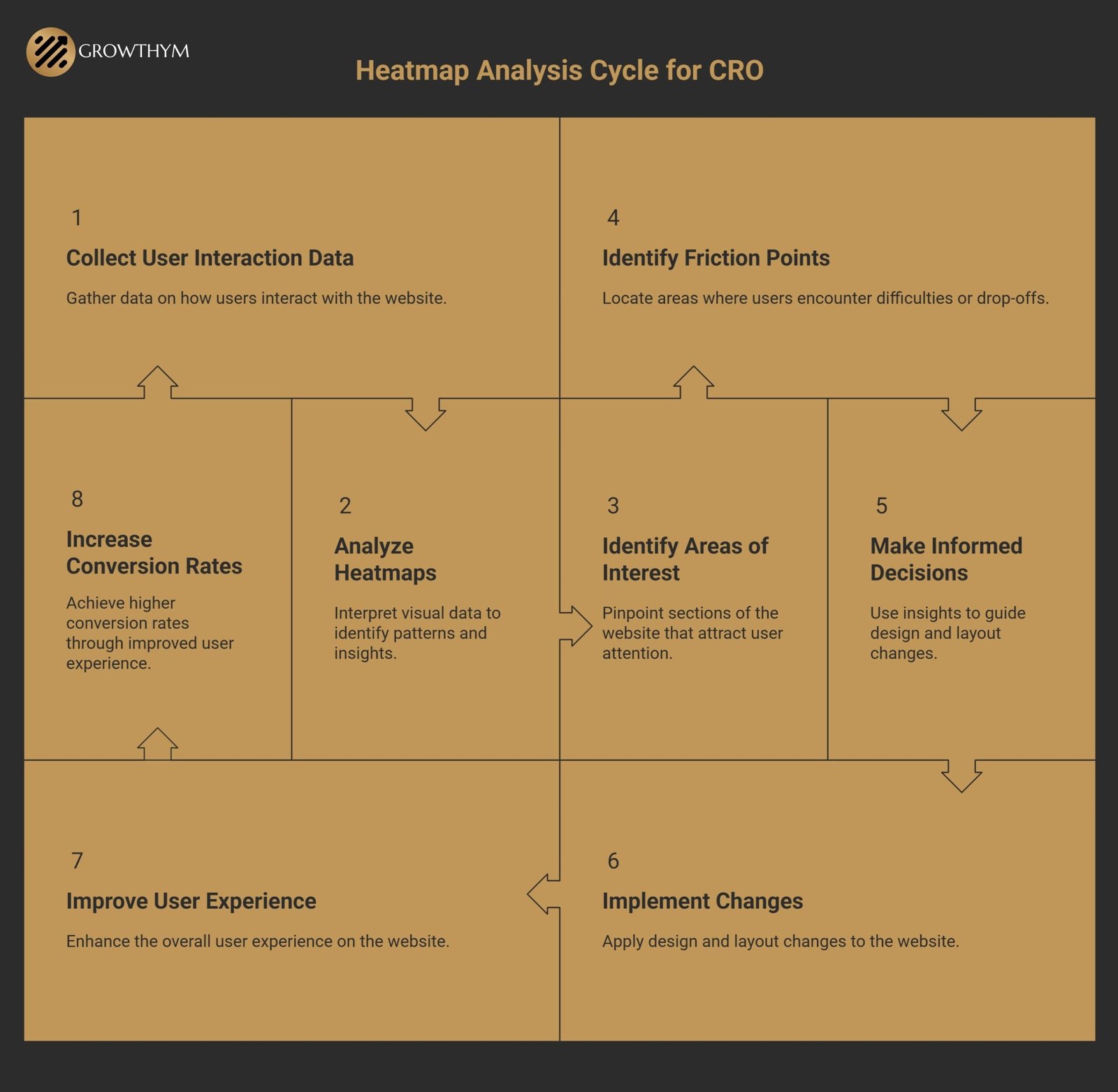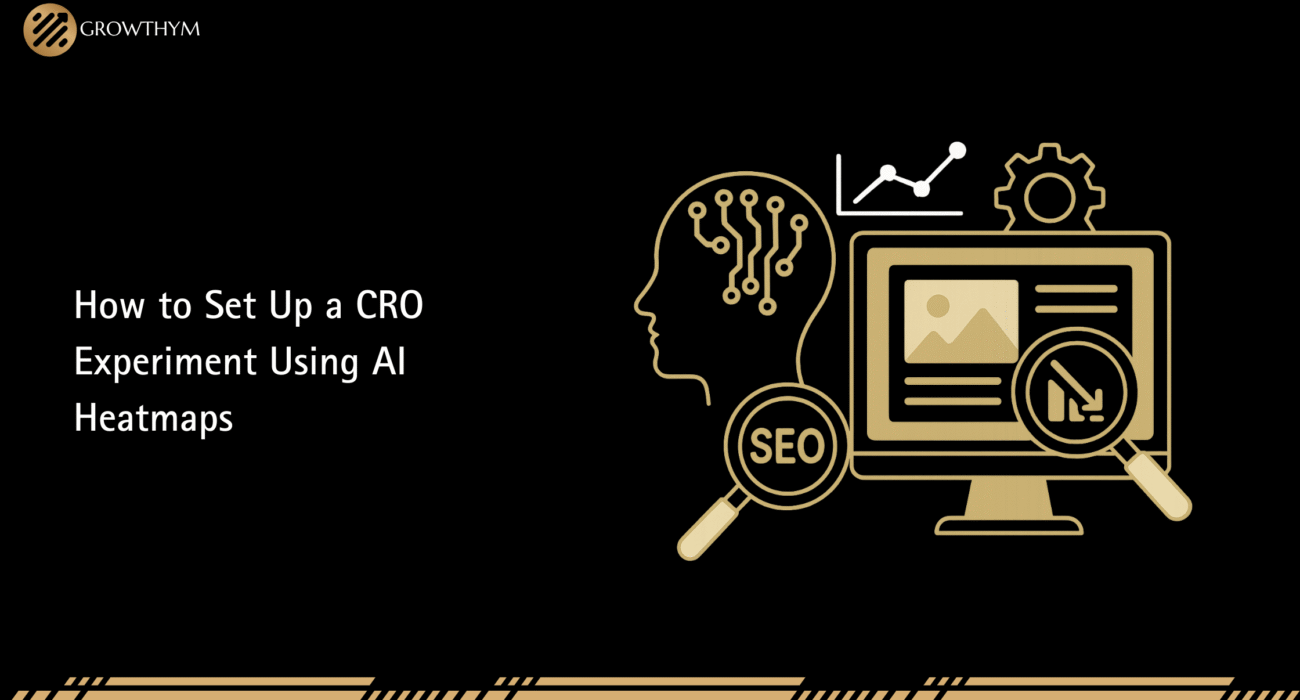Traffic is costly. Attention is short-lived. The only means of growth? Conversion.
Every click you earn has a cost – either paid, organic, or somewhere in between. Driving traffic is really only half the battle. The brands winning today are not just great at acquisition. Rather, they are obsessed with what happens after the click. That’s where CRO (conversion rate optimization) comes in. And that’s where AI tools are being used increasingly.
AI is now transforming how marketers and businesses analyze user behavior, run experiments, customize content, and make informed decisions. Growthym’s AI CRO services help businesses move faster, offering leadership clear visibility into what’s working and what’s not. Our advanced AI tools go beyond traditional analytics to track user behavior, uncover hidden friction points, and recommend winning changes.
With Growthym, you can set up and run CRO experiments that don’t just increase clicks, but rather drive measurable growth.
What is AI Conversion Rate Optimization?
CRO is a process to enhance the percentage of users who take desirable action on your website, whether that be sign-ups, purchases, or demo requests. Instead of relying on manual and slow A/B testing, AI CRO leverages machine learning, predictive analysis, and user behavior insights to find out what design copy or layout changes will make the most impact.
AI helps identify the conversion opportunities based on insights like tweaking the landing page content, email marketing content, or campaign interaction sequences.
What are AI Heatmaps?
AI heatmaps are predictive visualization tools that use artificial intelligence to suggest where users are likely to focus the most on a webpage, ad, or app screen. AI heatmaps differ from traditional heatmaps, which are based on real user data (i.e., clicks, scrolls, user mouse movement, etc), while AI heatmaps predict based on the design itself and apply machine learning and eye-tracking data models to predict how users will interact with different elements.
AI heatmaps show the areas that predict the most attention with warm colors (i.e., red, orange and yellow) and in cooler colors like blue and green is the least engaging areas, so marketers, designers, and CRO specialists can quickly see which areas of a page create or lose user attention (i.e., CTAs, headlines, images, forms, etc.). These provide quick predictive insights that enable businesses to structure their layouts and ultimately increase conversions without waiting for large sets of traffic data.
Types of Heatmaps
Depending on what your goal is, you can deploy a certain type of heat maps on your website, the most popular are:
-
Mouse Movement Heat Map
Mouse movement tracking tools keep a check on the movement of the mouse of the users and then represent the data visually over the page. It reveals a pattern behind how users read and navigate the page. This heat map can be used to validate your A/B testing on an e-commerce website to check what action they are taking.
-
Scroll Heat Maps
This map helps understand the idea of the point of the page till where users are scrolling down and where they actually leave the page. It divides the page into a number of folds. So, this way, you get an idea which fold the user was interested in your content.
-
Click Heat Maps
Click maps show that most of the users are clicking on a particular page. With these maps, you can remove the distractions and streamline the user experience. These are useful for spotting which buttons, links, or images drive engagement and which ones get ignored.
Why Use AI Heatmaps in CRO Experiment?
Using AI heatmaps in CRO offers valuable insights about how users interact with your website. Below is why you should use:
- Behavior Made Visible – They highlight hotspots where users spend the most time/clicks/attention so you can instantly spot high-performing areas and weak spots.
- Data-Driven Decisions – Instead of relying on gut feeling, you have actionable data on what’s working (and what’s not), so your CRO experiments can be more reliale.
- AI Precision – Unlike traditional heatmaps, AI-powered heatmaps use algorithms to predict human behavior, so you don’t need tons of traffic to see trends develop.
- Fast Testing – They are the quickest way to determine what and where you will change things (buttons, CTAs/images, layout) without taking months to run an effective experiment.
- Improved Conversions – By removing friction points and optimizing what matters to users, you will increase conversions without having to go through endless trial and error.
Step-by-Step Guide: Setting Up a CRO Experiment with AI Heatmaps
Now take a closer look at the steps:
- Define Your Conversion Goals
Before running any experiment, be clear about your goals, like what you want to achieve, like as more product purchases, form sign-ups, or demo requests. Having defined goals ensures your experiment is aligned with business objectives.
- Select the Right Pages for Testing
Focus on high-impact areas such as landing pages, pricing pages, or checkout flows where actions directly influence the revenue.
- Generate AI Heatmaps
You can upload your webpage design or live URL to an AI heatmap tool. And within seconds, the AI predicts where the user’s attention will go. It will show the hot zones and cold zones.
- Analyze User Attention Patterns
Carefully study the heatmap and look for blind spots, distracting elements, or misplaced CTAs. All these patterns will guide your optimization ideas.
- Form Hypotheses for Optimization
Based on the insights from heatmaps, form a clear hypothesis, for example:
- If we move the CTA higher on the page, more users will see and click it.
- If we reduce clutter around the form, completion rates will increase.
Strong hypotheses ensure your experiments test meaningful changes, not random tweaks.
- Create A/B Variations Based on Heatmap Insights
Build one or more variations and test one major change at a time so you can clearly see what drives results.
- Run the Experiment and Track Metrics
At this step, launch your A/B test and let it run long enough to gather statistically valid data. Track metrics aligned with your goals, like conversion rate, click-through rate, bounce rate, or engagement.
- Validate and Scale Successful Changes
Once you find a winning variation, release it to your entire user base. Write down your findings so you can take the learnings to other pages. Remember, AI CRO is a never-ending process, and you could repeat the cycle using new heatmaps and experiments for continuous improvement.
Common Mistakes To Avoid
While heatmaps are strong, they also have some drawbacks if not applied carefully. Hence, it’s vital to make sure your heatmap analysis is effective by avoiding these pitfalls:
- Ignoring Device Specific Behaviors
User behavior is not the same across devices. A CTA that is perfectly placed for desktop may be hidden below the fold for smartphones. Many businesses often forget to analyze both, which leads to missed opportunities. Therefore, it is better to run separate heatmap analyses for different devices.
- Relying on Heatmaps Only
AI heatmaps offer predictive insights, but it is also important to consider user feedback and other metrics. Validate through A/B testing or analytics. For real results, combine heatmap results with analytics.
- Testing Too Many Changes at Once
If you have changed multiple elements in a single experiment, you won’t know which changes drove the results. Hence, keep your experiments focused and test one variable at a time.
Potential Benefits of Using Heatmap Analysis in Developing Effective CRO Strategies
Heatmap analysis offers numerous benefits that can significantly enhance CRO strategies:
- Better Conversion Rates
Identifying what captivates users’ attention is vital for businesses to alter their pages to gain more attention to important factors (CTAs, etc). This alignment becomes directly correlated with higher conversions.
- Enhanced User Experience
Heatmaps remove the guesswork by providing accurate data regarding users’ actions. If you can better understand how users engage with your website, then you can create a more intuitive user experience that is enjoyable for the user. This can lead to longer visits and better user satisfaction.
- Well-Informed Decisions
Decisions about navigation, content placement, and design modifications are no longer based on guesswork but rather on actual user interactions when data-backed insights are used.
- Cost-Effective Optimization
Businesses can use heatmaps to make targeted and effective changes wth significant impact. This way, they can save resources and align with optimizing the process.
Overall, companies can establish a feedback loop for improvement by including heatmap analysis in AI CRO initiatives. Also, they can ensure their digital presence remains competitive and aligned with user expectations.

What’s the Future of AI CRO?
AI is transforming conversion rate rapidly, and its future looks even more promising. Now, businesses can use AI to predict user behavior, tailor experiences, and optimize in real time.
- Predictive Testing Before Launch
AI will facilitate heatmap analytics and behavioral models to help brands assess designs before they go live. These shifts will cut down on guesswork and accelerate iteration times.
- Hyper-Personalized User Journeys
AI tools will generate landing pages, product recommendations, and CTAs based on specific customer preferences and previous behaviors, as well as contextual factors including device, time of day, and more. Personalization will become the norm for AI CRO, rather than a bonus.
- Real-Time Optimization
Businesses don’t need to wait longer for an A/B test to conclude; AI systems will make the live changes based on incoming data.
- Voice, Visual, and Multimodal CRO
As online search and browsing are evolving, CRO won’t just focus on text and clicks. AI will optimize it for voice interactions, visual search, and even AR/VR experiences to ensure seamless conversation across emerging channels.
The future of AI CRO is faster and personalized. Brands that embrace the latest technologies will move to AI-driven growth.
Take a Heatmap Centric Approach
Heatmap analysis for CRO is an ever-evolving field. And with innovations like AI-driven insights, these promise to refine and speed up the analysis process, and provide even more accurate visitor behavior insights. As businesses gain greater clarity on user interaction patterns, they can efficiently cater to customer needs.
Using heatmap analysis for AI CRO not only unveils the complicated details of the user experience but also empowers digital marketers to make data-driven decisions that significantly enhance conversion rates.
If you also want to boost conversations with AI CRO, take advantage of Growthym’s AI CRO services. We use predictive intelligence to stimulate our journeys, find out bottlenecks, and automate rapid test cycles without a huge amount of traffic. Our AI CRO services help you increase conversions with data-backed insights. So, don’t leave conversions to chance; instead, optimize smarter today.
FAQs
How accurate are AI heatmaps as compared to traditional ones?
AI heatmaps are often more accurate and informative than traditional ones as they use machine learning to analyze intricate user interactions and forecast user behavior. They offer deeper and data-driven insights.
What is the difference between AI CRO and traditional CRO?
AI CRO automates the data analysis, tailors the experience, and conducts multivariate tests at scale using machine learning. On the flip side, traditional CRO is a manual and time-consuming process that depends on human experts to conduct A/B tests, track results, and make decisions.
How often should businesses run CRO experiments?
Businesses should run CRO experiments continuously rather than at fixed intervals. It is an ongoing process.
Can small businesses benefit from AI CRO?
Yes, even small businesses can leverage AI CRO services and improve conversions. A few small tweaks, like better CTA placement or simply forms, can make a huge difference.
What are the benefits of using AI for conversion rate optimization?
AI CRO lets you:
- Generate brand-aligned test creatives
- Forecast winning variants
- Discover high-impact test ideas faster
- Scale testing volume
Generate brand-aligned test creatives Forecast winning variants Discover high-impact test ideas faster Scale testing volume" } }] }

